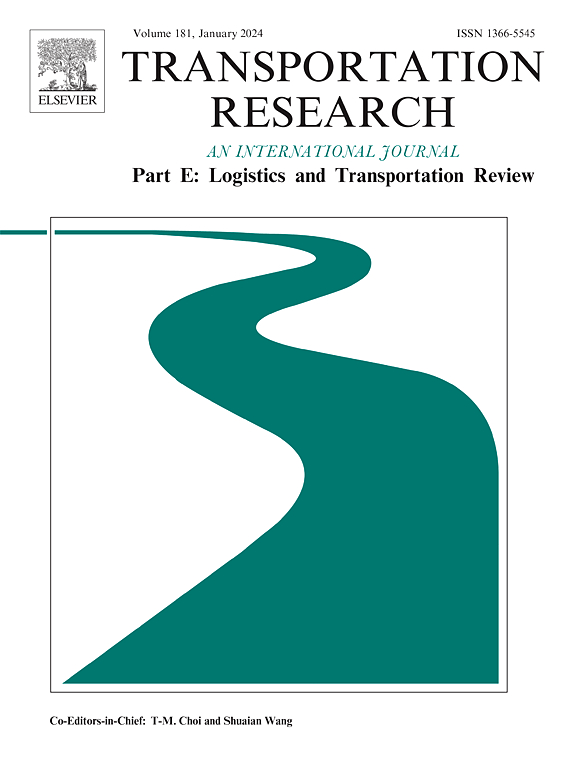双式联运快速交通网络的扩展——一种混合优化方法
IF 8.3
1区 工程技术
Q1 ECONOMICS
Transportation Research Part E-Logistics and Transportation Review
Pub Date : 2025-07-19
DOI:10.1016/j.tre.2025.104317
引用次数: 0
摘要
现有的研究主要集中在设计一个新的交通网络,而不考虑已有的网络。然而,大多数问题涉及重新设计或扩展已经存在的网络。考虑到城市中现有的多式联运网络,我们将分析方法和数学规划结合起来,制定了一个两阶段的方法来解决地面快速运输系统中双式联运网络设计问题(ETNDP)。在第一阶段,我们使用分析方法和连续近似来确定新站点的最佳位置。第二阶段,提出数学规划,同时确定快速公交线路的最优布局、每条公交线路的技术以及与所有公交路线(即现有路线和新路线)相关的服务车头。然后,引入了一种基于遗传算法的元启发式算法来解决实际规模交通网络的数学规划问题。提议的方法随后被应用于加拿大卡尔加里的快速运输网络,这是一个大型的双式联运快速网络。对卡尔加里的双模态ETNDP进行了各种情况下的求解,并对结果进行了讨论。分析表明,在本文提出的混合方法中,对部分问题进行解析求解可以显著降低问题的复杂性,并实现参数化分析,而使用数学规划有助于解决实际交通网络ETNDP的复杂性。所提出的方法从现有的类似研究中脱颖而出,因为它脱离了对网络拓扑、城市结构、捕捉任何类型的需求模式、现有交通网络扩展的模型灵活性以及快速交通网络的多模式的简化假设。本文章由计算机程序翻译,如有差异,请以英文原文为准。
Expansion of bi-modal express transit networks − a hybrid optimization approach
Existing research has predominantly concentrated on designing a new transit network without considering the pre-existing network. However, the majority of problems involve redesigning or extending an already existing network. Considering the pre-existing multi-modal transit network in a city, we have integrated analytical methodologies and mathematical programming to formulate a two-stage approach for addressing the bi-modal express transit network design problem (ETNDP) within the context of a surface express transit system. In the first stage, we use analytical approaches and continuum approximations to identify the optimal locations of new stations. In the second stage, mathematical programming is proposed to simultaneously determine the optimal layout of express transit routes, the technology of each transit route, and the service headway associated with all transit routes (i.e., existing and new routes). Then, a metaheuristic algorithm based on a Genetic Algorithm is introduced to solve the proposed mathematical programming for real-size transit networks. The proposed approach has then been applied to the express transit network of Calgary, Canada, a large-sized bi-modal express network. The bi-modal ETNDP has been solved for Calgary under various scenarios, and the results have been discussed. Analyses show that, in the proposed hybrid approach, solving a part of the problem analytically reduces its complexity significantly and enables parametric analysis, while using mathematical programming helps to address the complexity of ETNDP for real transit networks. The proposed approach stands out from existing similar studies due to its departure from simplifying assumptions concerning network topology, the city’s structure, capturing any type of demand patterns, model flexibility to for existing transit network extension, and multi-modality of the express transit network.
求助全文
通过发布文献求助,成功后即可免费获取论文全文。
去求助
来源期刊
CiteScore
16.20
自引率
16.00%
发文量
285
审稿时长
62 days
期刊介绍:
Transportation Research Part E: Logistics and Transportation Review is a reputable journal that publishes high-quality articles covering a wide range of topics in the field of logistics and transportation research. The journal welcomes submissions on various subjects, including transport economics, transport infrastructure and investment appraisal, evaluation of public policies related to transportation, empirical and analytical studies of logistics management practices and performance, logistics and operations models, and logistics and supply chain management.
Part E aims to provide informative and well-researched articles that contribute to the understanding and advancement of the field. The content of the journal is complementary to other prestigious journals in transportation research, such as Transportation Research Part A: Policy and Practice, Part B: Methodological, Part C: Emerging Technologies, Part D: Transport and Environment, and Part F: Traffic Psychology and Behaviour. Together, these journals form a comprehensive and cohesive reference for current research in transportation science.

 求助内容:
求助内容: 应助结果提醒方式:
应助结果提醒方式:


